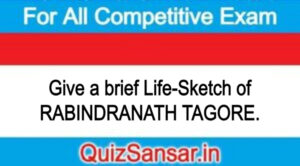
Give a brief Life-Sketch of RABINDRANATH TAGORE.
Give a brief Life-Sketch of RABINDRANATH TAGORE.
Ans.
RABINDRANATH TAGORE (1861-1941)
His Birth and Parentage
Rabindranath Tagore was born in Calcutta on 7th May, 1861. He was born in a distinguished Brahmo family of Bengal. His grandfather, Dwarkanath, was called the Prince of his lavish style of living. His grandfather was an intimate friend of Raja Ram Mohan Roy who was a great thinker and social reformer. He was a practical man of affairs. Tagore’s family was rich and highly cultured family. Tagore’s grandfather had amassed much wealth through business transactions and the Tagores lived in luxury. However, towards the end of his life the Prince suffered heavy losses, and when he died in 1846 he left the family heavily indebted. Dwarkanath’s eldest son, Debendranath, was a sedate and thoughtful. He joined the Brahma Samaj and avoidly read the Upanishads. After his father’s death he had to administer the entire zamindari but he avoided chicanery and fairly and squarely managed all affairs. Rabindranath’s father Dabendranath was not only an original thinker and philosopher, but also a man of great honesty and integrity, courage and determination. That he was a great soul who was held in high esteem is borne out by the fact that he was called Maharishi. Maharishi paid off all the debts and redeemed the family Zamindari both in Bengal and Orissa. By the time Tagore was born in 1861, the family had recovered from its financial difficulties and was tolerably well-off. The poet’s mother, Sarla Devi, was the mistress of the big household. She was so awfully busy in domestic chores that she could pay hardly any attention to her children.
The Death of His Wife, Daughter and Disciple and His Consolation Giving Poems
The shadow of death clouded the poet’s life. It was unfortunate at this time that his wife died (1902) leaving him disconsolate with five children. A series of touching lyrics in memory of his wife were composed by him and he called them Smaran (Remembrance). He also wrote a number of poems to soothe and entertain his youngest child and second son Samendra, and named them Sisu (the child). His wife’s death soon after was followed by the death of his second daughter, Renuka and later on his favourite disciple, Satish Roy died in 1904. His father died in 1905 and his youngest son in 1907. These bereavements induced a mood of renunciation in him. But despite his sorrows his spirit remained invincible and failed to break the stream of his activities. He seemed to have entered into peace and death which the poet accepted as part of the rhythm of life.
His Winning Nobel Prize
In November 1913, Tagore was awarded the Nobel Prize for literature for the English translation of Gitanjali. He was greatly honoured wherever he went. An honorary doctorate was conferred on him by Calcutta University the same year. In 1914, he was knighted.
His Visit to Japan and America
In 1916, Tagore left for Japan. From Japan he went to America. He was given a splendid ovation wherever he went. In America he delivered a series of lectures which were collected in two slim volumes Personality and Nationalism.
- What is meant by Database Management System?
- Discuss the advantages and drawbacks of database.
- What do you mean by database ? Discuss its Characteristics.
- What is Data Mining?
- What are the conditions of communication?
- What do you mean by business communication ?
- organization / Differentiate between classical and modern theory of organization
- What is forecasting






